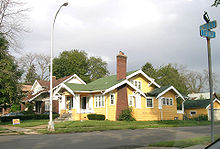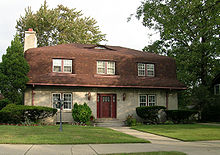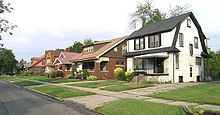- Medbury's-Grove Lawn Subdivisions Historic District
-
Medbury's--Grove Lawn Subdivisions Historic District
 Streetscape on Puritan near Woodward
Streetscape on Puritan near WoodwardLocation: Highland Park, Michigan Coordinates: 42°24′46″N 83°6′28″W / 42.41278°N 83.10778°WCoordinates: 42°24′46″N 83°6′28″W / 42.41278°N 83.10778°W Architect: Leonard B. Willeke, Et al. Architectural style: Colonial Revival, Bungalow/Craftsman, Tudor Revival Governing body: Private NRHP Reference#: 88000049[1] Added to NRHP: February 08, 1988 Medbury's-Grove Lawn Subdivisions Historic District is a residential historic district located in Highland Park, Michigan. It runs along three east-west streets: Eason Street, Moss Street, and Putitan Street, from Hamilton Avenue on the west to Woodward Avenue on the east. The district was listed on the National Register of Historic Places in 1988.[1]
Description
The Medbury's-Grove Lawn Subdivisions Historic District is a residential neighborhood of single-family, detached homes.[2] There are 272 homes located within the district, with 251 of them classified as contributing to the district's historic character.[2]
The neighborhood was built up primarily in the 1910s and 1920s, and features a variety of architectural styles that were popular at the time.[2] Bungalows and bungalow-style houses with Craftsman or colonial details predominate, and, in fact, the neighborhood is significant for containing Michigan's most outstanding collection of single-family bungalows and bungalow-style homes. However, foursquare, colonial revival, and English cottage homes are also present within the neighborhood.[2] The homes in the district are notable for their variety and the level of craftsmanship and detailing, and are excellent examples of the variety found in American suburban domestic architecture of the period 1900-1930.[2]
The district also contains 272 garages and sheds, located along alleys behind the homes.[2] Of these, 250 appear to date from the neighborhood's original development, and reflect the upwardly-mobile, middle-class character of the neighborhood.[2]
References
- ^ a b "National Register Information System". National Register of Historic Places. National Park Service. 2008-04-15. http://nrhp.focus.nps.gov/natreg/docs/All_Data.html.
- ^ a b c d e f g Medbury's-Grove Lawn Subdivisions Historic District from the state of Michigan
U.S. National Register of Historic Places Topics Lists by states Alabama • Alaska • Arizona • Arkansas • California • Colorado • Connecticut • Delaware • Florida • Georgia • Hawaii • Idaho • Illinois • Indiana • Iowa • Kansas • Kentucky • Louisiana • Maine • Maryland • Massachusetts • Michigan • Minnesota • Mississippi • Missouri • Montana • Nebraska • Nevada • New Hampshire • New Jersey • New Mexico • New York • North Carolina • North Dakota • Ohio • Oklahoma • Oregon • Pennsylvania • Rhode Island • South Carolina • South Dakota • Tennessee • Texas • Utah • Vermont • Virginia • Washington • West Virginia • Wisconsin • WyomingLists by territories Lists by associated states Other  Category:National Register of Historic Places •
Category:National Register of Historic Places •  Portal:National Register of Historic PlacesCategories:
Portal:National Register of Historic PlacesCategories:- Historic districts in Michigan
- National Register of Historic Places in Michigan
- Historic districts in Wayne County, Michigan
Wikimedia Foundation. 2010.




